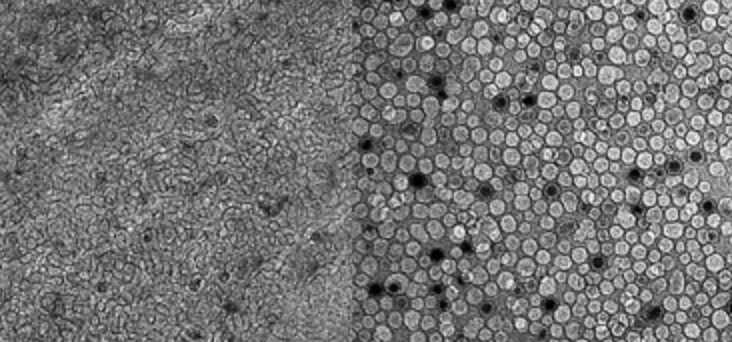Emulsion
An emulsion is a dispersion system formed by two (or more) non-mutually or partially mutually soluble liquids. The aqueous phase in the emulsion is denoted by W and the organic phase is denoted by O. If the organic phase exists as a discontinuous phase dispersed in the water phase, it is called the oil-in-water type, represented by O/W. If the water phase exists as a discontinuous phase dispersed in the organic phase, it is called the water-in-oil type, represented by W/O. Also, multiphases are represented as W/O/W, O/W/O, etc.
As the emulsion volatilizes at a high temperature, it cannot be treated by vacuuming, so cryogenic electron microscopy (cryo-EM) becomes an important tool for emulsion analysis. The vesicle structure formed by the layered intermediate in the emulsion can be observed by cryo-EM imaging.
 Figure 1. Cryo-EM imaging of a novel microemulsion system of silicone oil with an
Figure 1. Cryo-EM imaging of a novel microemulsion system of silicone oil with an
anionic/nonionic surfactant mixture (Wolf L, et al. 2010)
Compared with liposomes, nanoparticles and other carriers, emulsions have unique advantages in drug screening due to the dispersed phase of surfactants. Our cryo-EM platform uses the latest ultra-high resolution electron microscope mode, which can determine the state of emulsions (micelles/vesicles) based on their microstructure. We can also use cryo-EM to observe the relationship between different surfactants concentrations and the microphase stability, which has a guiding role in the direction of the chemical industry and pharmacy.
If you are interested in our emulsion analysis using cryo-EM technology, please feel free to contact us. We are looking forward to cooperating with you.
Ordering Process
Reference
- Wolf L, et al. Cryo-TEM imaging of a novel microemulsion system of silicone oil with an anionic/nonionic surfactant mixture. Soft Matter. 2010. 6(21): 5367-5374.
